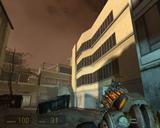Page 1 of 1
Halflife 2 Episode 1
Posted: Thu Jun 01, 2006 10:14 pm
by Bwall
In case you didn't hear, it came out today. I have to say that I really like this game. It was short but very good. If anyone is interested in some screen shots I have some at 1920x1200 that I can link here.
Posted: Thu Jun 01, 2006 10:23 pm
by infinitevalence
i would not mind afew but make them smaller for the other people in the forum.
Im thinking i will get it this weekend and give it a play, im not totaly sure its worth $20 for only 6hrs of game play with HDR... but we shall see.
Posted: Thu Jun 01, 2006 11:07 pm
by -mogwai
i ordered it a week or so ago on buy.com....
Posted: Fri Jun 02, 2006 12:32 am
by Dragon_Cooler
do you play as alex this time?
Posted: Fri Jun 02, 2006 5:32 pm
by Bwall
You still play as Gordon but Alex plays a large part in the game.
These screen shots are 1920x1200 2xAA/16xAF with High Quality enabled in Nvidia drivers. HDR was on "Full" in the HL2 E:1 control panel.
All but one screen shot is over 400k. I can provide more but I tried to post only shots that revealed as little of the story as possible.
http://birch.net/~lindsayf/ep1_1.jpg
http://birch.net/~lindsayf/ep1_2.jpg
http://birch.net/~lindsayf/ep1_3.jpg
http://birch.net/~lindsayf/ep1_15.jpg
http://birch.net/~lindsayf/ep1_16.jpg
http://birch.net/~lindsayf/ep1_19.jpg
Posted: Fri Jun 02, 2006 5:59 pm
by Antonik
Thanks for the screenshots, looks awsome.
Posted: Wed Jun 07, 2006 9:24 am
by stereo55
Fun game so far with nice graphics .
Anyone interested in the game , its available at Target for $14.99

Also available at Frys/Outpost for a mear $12.99

( not sure if sale is still ongoing)
Posted: Wed Jun 07, 2006 10:07 am
by infinitevalence
yeah spent 2 days downloading it... dont ask... and i still cant play it i get a shaderpix9.dll error, i folowed their directions to fix this problem and its a no go.... im very sad at the moment.
Posted: Wed Jun 07, 2006 10:54 am
by werty316
Yeah this game is badass but too bad it is so short. Also HDR and AA both work together.
Everthing maxed out at 1280x1024


Posted: Wed Jun 07, 2006 12:02 pm
by tomato
Whoa, cool pics, werty!

Posted: Wed Jun 07, 2006 11:12 pm
by Kerii
Yup, having that HDR+AA for the first time, I don't know how I'll go back.
Good on those guys at Valve for figuring out a workaround, and a very fast and efficient one no less!
Runs great on the 7800GT (500/1160) at 1280x960 4xAA 16xAF, very little stuttering and then only at load points.

Hated HL2, love Ep1, much more fast paced and immersive like Quake4. Not to mention a lot less physics engine mastrubation (though there is still some).
Posted: Thu Jun 08, 2006 8:50 am
by Dragon_Cooler
quit it, now i am more inclined to get it! LOL
Posted: Thu Jun 08, 2006 9:21 am
by kenc51
I dunno about nVidia using AA + HDR!!
I t migh be using Bloom effect or something, but nV can't do AA + HDR at the same time!!!!
Thant's ATI's domain

Posted: Thu Jun 08, 2006 10:30 am
by Bwall
Yes, with Source and NVIDIA+AA works. There are several methods of using HDR and Valve has taken a different approach that has great advantages yet makes some compromises. Although their approach isn't the most cutting edge, to me anyway, they have the best use of HDR yet.
Some HDR reading:
http://en.wikipedia.org/wiki/High_dynam ... _rendering
And here is text taken from Anandtech
Anandtech:
Valve’s HDR Source Implementation
We recently had the opportunity to head up to Washington to visit with Valve and talk about the new additions to the Source engine. After the issues and delays getting Half-Life 2 out the door, Valve's philosophy on game development has shifted. Rather than setting a long term goal to take one project from start to finish, Gabe and the team will be setting shorter term release goals. The idea is that five one-year projects on the road to a five-year destination can help keep them on track. We can also look forward to incremental updates to the Source engine allowing other game developers to benefit constantly from new technology, bringing us nice little treats like HDR.
As a result of the past year of development, Valve has met their goal to incorporate HDR into their Source engine and now we get to reap the benefits. But before we look at performance numbers and image quality, we will take a look behind the scenes to find out what is going on. At first glance, it is clear that Valve has added the usual blooming features that we would expect from HDR rendering, but there are a couple of new features that Valve has added to keep it interesting.
As we have said, HDR generally speaks to representable contrast in a scene. The way that developers handle this is to represent brightness data beyond the capabilities of the display (for instance, the sun is much brighter than a light bulb, but both could be the same color with traditional rendering). That isn't to say that a game or other HDR applications can make your monitor brighter than possible, but rather that internal light sources and objects in an application can be represented by more brightness than can be displayed. The final rendered image is then (in current incarnations) tonemapped down to a standard 8-bit display colorspace.
This allows objects that are only partially reflective to still reflect enough light to be as bright as what the monitor can display. For instance, a rock in a game may be 20% reflective. Normally rendered, even if a bright light source is perfectly reflected to the camera, the rock can only be 20% as bright as what the monitor can display. If the light source shining on a rock is 5 times brighter than the display, the rock will still be able to reflect a light that shines at 100% of the monitor's brightness.
In addition to this feature, very bright lights also make it more difficult for our eyes to clearly see objects occluding (or nearly occluding) the light source. The effect that game developers use to portray this "bloom" is to blur the light onto the foreground object. The high dynamic range allows light sources to be identified and properly handled.
One of the easiest ways to implement HDR from scratch is to use a floating point format with all art assets designed around HDR. Unfortunately, current hardware isn't able to handle full floating point data as fast as other methods, and no hardware (that is currently out) can allow MSAA to run on a floating point render target. The size of the artwork needed to make this work is also huge and floating point assets cannot be compressed currently using built-in hardware texture compression techniques. On top of this, Valve is working with an existing engine designed around Half-Life 2, so this method would also require a redesign of art assets and how they worked. These problems and others add up to make it difficult to incorporate this technology in the Source engine.
So, rather than carry HDR data through the entire pipeline and all art assets, Valve made a different choice that gives a good balance of performance and HDR characteristics. Data is represented in fp16 or integer 4.12 linear space through in light sources cube maps and static lighting data. This method is unable to store overbright information directly, but Valve is still able to add a blooming shader. Our understanding is that this method eliminates the possibility for transmissive or refracted overbright data (we won't be able to see a bloom inside a stained glass window or from sand under water through which light has passed). But blooming light sources and direct light reflection is still possible and well used in the Source engine.
But on top of blooming, Source also allows for dynamic tonemapping that works something like an auto exposure or a human pupil. This helps maintain a high dynamic range effect without overbright data by allowing the natural lighting of a scene to dictate the exposure of the rendered image. This means that in a dark room, the tonemapping scale will adjust to (essentially) make the brightest parts of the darkness bright enough to see with the natural light. The mapping isn't linear so that very dark pixels are brightened less than lighter pixels. In a bright room, the opposite is true, but in both cases, the definition of HDR is fulfilled: the contrast ratio between bright and dark areas on the same image is greatly increased.
To handle the tonemapping, Valve artists design three different images for the skybox at three different exposures. HDR light maps are built from the environment using a global illumination model and radiosity that uses 8 bounces. The process of generating HDR light maps takes a while, but (together with the HDR cube maps built from the HDR light maps and the skybox) this also allows Valve to represent correctly the lighting of the world. Entire maps can be lit with only the sun as a light source. Normally, to brighten hallways or dark areas away from static lights, small point lights are used. This is no longer necessary and can actually make the scene look bad. Not to worry though, level designers can build HDR lighting information into the same BSP as non-HDR lighting data and the engine will select the right ones to use depending on the mode in which the game is running.
The HDR SDK for source will ship when the Lost Coast level is released. This will allow modders to implement HDR levels in their games by adding the three exposure sky maps, building HDR and non-HDR lighting into levels, and setting bloom and exposure ranges per area if desired. While bloom and exposure can be handled automatically, it is nice to give the developer control over this.
And now that we've seen how it's done, let's take a look at the end result in performance and image quality.
Posted: Sat Jun 10, 2006 10:46 am
by werty316
Not sure if its bloom or HDR but here is an example of it with AA and HDR combos enabled and disabled.
HDR-Off AA-Off

HDR-On AA-Off

HDR-On AA-On

I am not really sure what bloom looks like but you can notice the difference. The settings says its "HDR" so it has to be "HDR".
Posted: Sat Jun 10, 2006 10:51 am
by stereo55
BTW ...fatwallet is reporting E1 will be onsale @ Circuitcity for $7.99 , starting 6/11 !
Posted: Sun Jul 09, 2006 7:43 pm
by Topher
fatwallet is reporting E1 will be onsale @ Circuitcity for $7.99 , starting 6/11 !
Dunno about that but Wal-Mart has it for $14.50 right now.




